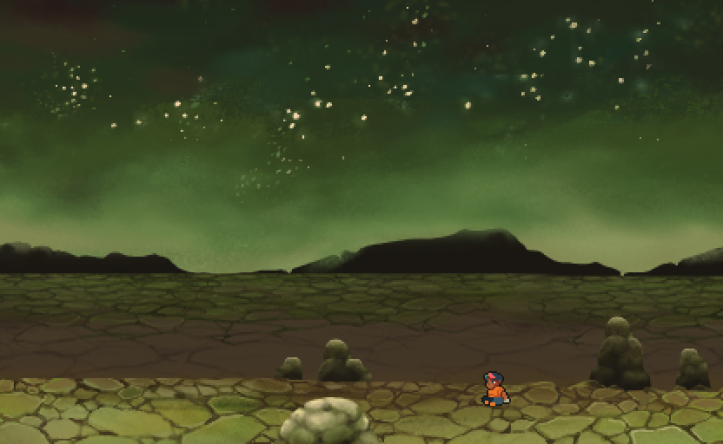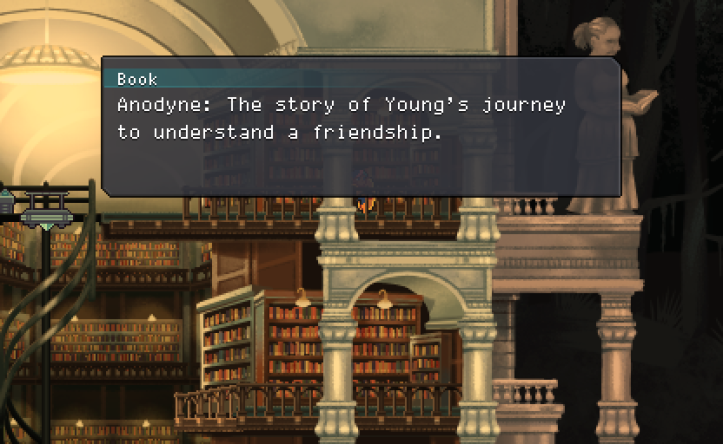The world is a balance of dark and light energy, horizontal and vertical. Whiteforge City stands as a shining beacon of civilization, empowered by power plants scattered around the continent, technological marvels made in balance with nature. After an accident that kills her senior, a woman named Aliph is tasked to check on the power plants, which are threatened by odd biological monsters that may herald greater disasters.

Even the Ocean is brought to us by Analgesic Productions, consisting of the duo of Melos Han-Tani and Marina Kittaka. The duo were previously responsible for Anodyne, a Link’s Awakening-like game.
Initially there were two games, Even and The Ocean, with the first focusing on a mundane modern day setting while The Ocean would have been fantastical and abstract, like Anodyne. This idea was later dropped, with the concepts of Even being integrated into The Ocean to form one big whole. Even the Ocean has explicit structure and themes that are wrapped around a setting with odd setpieces; I’d say that Even the Ocean carries the surreal mood of Anodyne without having an abstract narrative. If you were one of those people that liked the surreal aspects of Anodyne but hated the story and themes being extremely vague, Even the Ocean is definitely an improvement.
Aliph is seeked out by Mayor Biggs, who assigns her to investigate power plants that are in trouble. She’s set up to be a heroic figure, which one of Aliph’s co-workers suggests is propaganda. It’s not hard to see why, looking at Whiteforge. The city is split up into two, with the Apex District a bright tower towering over the rest of the city. There’s also a huge class and racial divide, with most of the residents living in Apex being affluent and white while the rest of the city isn’t as well off and many of them are colored. Suppose that the city presents Aliph as its champion to downplay those issues.

Aliph’s detached working life is balanced with the downtime segments at home and the nature segments before the power plant proper. The nature segments has her meeting up with the odd characters inhabiting that slice of nature, sometimes having their own life problems, sometimes rambling their personal philosophies. While these segments gives a human element to the game, the philosophical ramblings kinda bothered me in that a lot of them felt abrupt. Anodyne sort of had them, but with how abstract the game felt, the musings felt like they fit in. Even the Ocean however is more concrete and grounded, so talking to somebody who suddenly bursts into a monologue about life feels kinda off-putting.
One of the general messages of Even the Ocean is an environmentalist one, with the troubles in the story being a metaphor for climate change. Looking at other reviews, people see the message as old-hat or overly-preachy. However, while people feel that it’s a message that’s been preached a lot, that message is more important than ever, with the recent destructive hurricane season being emboldened by a warming climate. Also, while not explicitly mentioned, this is one of the few works I’ve seen that points out that poor people and the marginalized would end up suffering the most from climate change, even if they contribute little to it. It isn’t a coincidence that the rich, mainly white Apex District is causing most of the energy imbalance that leads the world to disaster, situated above the Earth to leave the colored majority of Whiteforge to suffer the worst effects of their transgressions.
A problem that I kinda had with the story was its pacing. After each platforming heavy segment, Aliph insists on heading home and while that sometimes leads to important character building scenes, there are times when nothing much happens, making heading home feel unnecessary. I feel that the problem was made worse by the world map segments, which are non-eventful stretches of time that you have to go through every time you have to go places. Which is often, due to Aliph’s insistence of doing each dungeon one at a time and taking breaks afterward. It’s kind of a nusiance and I definitely see it as a problem for people that just want to get into the platform heavy parts of the game.
But! If you’re one of those players, the game offers the Gauntlet Mode. Gauntlet Mode removes the narrative parts of the game (except for some small bits of story), leaving only the platforming power plant segments. Alternatively, if you care more about the story but aren’t about those segments, there’s the Story Mode that’s nothing but the narrative parts and the easy platforming in them. The game’s pretty accommodating of different players, which is something to appreciate.

So, let’s get into gameplay. The central mechanic in Even the Ocean is energy balance, a bar showing the amount of light-to-dark energy that Aliph has taken. Aliph by herself controls pretty well, smoothly running and jumping, using her shield to propel herself and block stuff. How she moves can be altered depending on her energy balance. If she has a lot of light energy – the vertical energy – she walks slower but her jumps are high. Conversely, a more dark energy aligned Aliph can cover distances faster but her jump is low. However, if the bar is completely filled with one type of energy, Aliph gets overwhelmed and dies.
The world is full of environmental hazards and traps that fills Aliph with energy. However, that’s not to say that they’re inherently dangerous. Often times you’ll be letting yourself get hit by energy projectiles or walking through energy fields to maintain balance or for the sake of a puzzle. Maybe you want to cheese some jumping segments and so allow yourself to get shot with just enough light energy that you don’t die. Looking at the options, Even the Ocean is a game that encourages speedrunning and I imagine that the most efficient way of speedrunning the game is allowing yourself to swing between energy extremes to get through levels quickly. Probably would be a fun thing to do if my computer could actually handle recording things.
The game consistently stays fresh by introducing different mechanics. Early levels introduce energy shots that can be blocked with your shield, while a later level has shots that are instead reflected, which you’d need to activate switches. It’s easy to pick up on new level mechanics and there wasn’t a place in the game where I felt stuck. That said, it can be argued that the game is too easy for people just casually playing it through. Even the Ocean feels good to play, but challenging it is not.
My favorite set of platforming segments is definitely the fourth set. Describing them would be a spoiler, but I can say that they have a unique feel and look compared to other segments, with new mechanics being introduced in unorthodox forms befitting of the context. Unfortunately, the game’s last level ends up feeling weak, as it comes right after this set of levels and to me came off as a pop quiz sort of level where you just apply everything you learned; it also didn’t really have the kind of gravitas that you’d expect from the last level, especially with the context surrounding it.

The game’s art, by Marina Kittaka, is just fantastic. The pixel art of Anodyne is left for sprites while the main environments outside of the platforming segments are gorgeous paintings. Even mundane areas feel lush with Marina’s style, with her great use of colors and detail. The platforming segments are weaker visually, with terrain being constructed through tilesets, but that might actually be the point. The narrative segments with their painted worlds feels very natural, while the use of tilesets for the power plants gives an artificial man-made feel, creating a balance that’s very much in line with the game’s setting and themes.
As a quick aside, if you like Marina’s art for the game, I suggest you check out her writings. They’ve recently started a retrospective series of essays on the game’s art, which also includes a nice history of how the game’s art style transitioned throughout development, so it’s an interesting read, especially if you’re a game artist.
Melos Han-Tani’s music is also a really strong factor of the game. The soundtrack generally gives off a calm, dreamlike vibe with its instruments. The music for the nature segments feels mysterious as you head to parts unknown, while music that plays in Whiteforge feels welcoming, especially Aliph’s own theme when she’s at home. The music for the more platform heavy segments are more energetic, though it rarely strays from the soundtrack’s general mood with the soundtrack’s instrumentation. I found Even the Ocean‘s soundtrack delightful to listen to and as somebody that enjoyed Anodyne‘s soundtrack, I think that Even the Ocean‘s is stronger; not sure how to put it, but Even the Ocean‘s soundtrack feels more unified, if that makes sense?

Even the Ocean is a gorgeously presented narrative platformer, though it is an easy one with weird pacing. People that are into challenging platformers aren’t likely to be satisfied, but if you’re a person that likes a story and relaxed platforming, Even the Ocean is something that I recommend.

I’m assuming the gauntlet mode is available after you beat the game?
LikeLike
No no, both Gauntlet and Story modes are available from the start!
LikeLike
[…] Asias is a narrative game by Sean Han Tani, most known for his work on Anodyne and Even the Ocean (which I previously wrote about) with Joni Kittaka. It’s a story of a young man named Yuito that wants to learn about his […]
LikeLike
[…] Even the Ocean […]
LikeLike
[…] version of their first game Anodyne. Thematically, the game reminds of the environmental themes of Even the Ocean (which oh boy probably feels worse to play today) and the cultural musings in Melos’ solo game […]
LikeLike